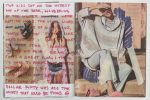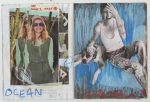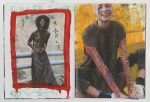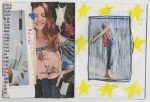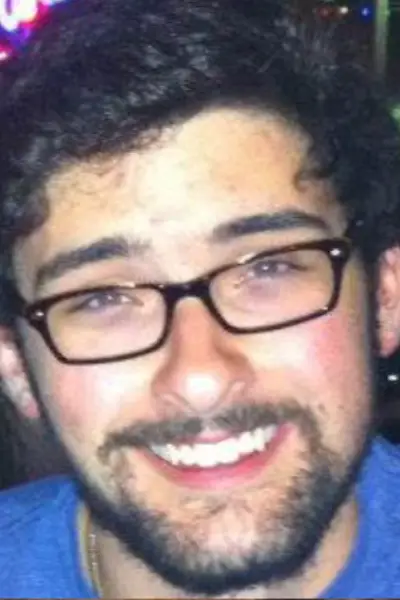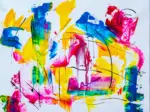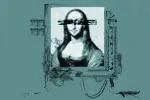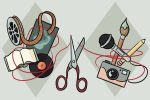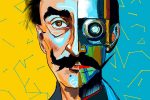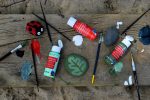Nicholas Osella, the founder and principal artist behind StudioWOS, wears his art on his sleeve quite literally.
Upon meeting him at the Cafe Creme in Austin, Texas, I quickly noticed that his clothing was covered in glyphs and symbols that had been painted on. To a man like Osella, everything can become a canvas.
“I stopped painting on standard canvases,” he says. “l loved painting, but I don’t do that anymore. I’m taking a very brutalist approach to doing art. I paint on objects. Radios, clothes.”
Remixing, or taking objects in the real world and transforming them into art pieces, is one of Osella’s preferred forms of expression. He’s brought some of his art with him, this time a couple of remixed women’s magazines. But, before taking me on a tour of his work, I ask about his outfit.

“The jacket I’m wearing right now, I painted on it.” He points to a few of the symbols, one of which is unique to StudioWOS. “This is my logo. I’ve been doing this since high school,” he says.
His shoes bare the same insignia. Osella places the two women’s magazines that he’s remixed on the table and walks me through each page. His work includes complete structural rearrangement of certain pages, with elements of collage. An interesting double-vision effect is achieved by tearing a page in one place and inserting the same image from another identical magazine.
Stream of consciousness poetry covers some pages completely, while spray paint works to form entirely new backgrounds for pictured models. Typed words are crossed out, rearranged or erased completely with colors. The magazine, once orderly, is transformed into something far more personal to its new owner. It’s street art for the printed press.
The work he shows me is only a small sampling of his remix art; in fact, I first heard of Osella after he sent in a remixed version of a Study Breaks magazine to its office. He had picked up the magazine from the University of Texas campus, where he studies graphic design, an academic pursuit that, in a way, helps inform his style.
“I’m studying graphic design, which is not art. So, I have to do it in my spare time and find some kind of common ground between design and art. The work I made for Study Breaks is kind of the closest I’m getting to this specific art-piece design I’m building toward.”
Osella’s work tells a story of loss, anxiety, love and personal articulation. Stray poems in the magazines carry nostalgic ponderings and existential worries. StudioWOS was born from a tragedy that moved Osella to face the world with a newfound understanding of life’s fragility.
“A lot of it is storytelling,” he says. “As an artist, you’re always telling a story. In high school, you’re this other person. And I think everyone can identify with that. You were this person, and now you’re not.
“I was born and raised in Austin and went to St. Andrew’s Episcopal School. My friends and I had gone to the same private school for years, so we were very close. When high school came, some of us went to different schools. One of my best friends, Jamie, went to Austin High. We met really young. We were always in the same grade. He was having a lot of anxiety issues and was on some medication.
“When we were freshman, he killed himself due to complications of this drug he had taken. [His death] was a big formative part of who I am now. I think of it everyday when I wake up and when I go to bed. I carry it with me all the time. It’s a very dark thing, but finding the light in it early, finding some purposeful meaning in it, was healthy for me. And I know it impacted my friends, all of us, and caused us to grow up very quickly…come to term with things we didn’t want to.”
The loss of his friend paved the way for Osella to use art as a way to cope with loss. Despite its inspiration being rooted in misfortune though, the symbol for StudioWOS is a smiley face.
“The character I use in my art is named WOS. WOS is an acronym that can stand for anything. Walking On Sunshine, Walking Over Sand. It represents Jamie and me, and how I stay connected to him as a person. After someone dies, you can completely forget they existed. After we leave this conversation, I could die or you could die. The only thing that keeps us alive is the pictures and images that represent us.”
Osella’s interest in creating his own form of art was encouraged by his high school mentor, Chris McCoy. McCoy pointed Osella toward the work of Keith Haring, an American artist and social activist.
“He stood for so many things — AIDS awareness, drugs. He was kind of a martyr. I really resonated with that. Growing up and learning about him, I’d be really impatient with my art. I would mindlessly create with his teachings. It was like being an understudy,” he says.
Now, Osella explains, StudioWOS is a path all his own.
“This is the only time in my life where I’m not constantly looking at him and making things because of him, but now making things because of what I’ve learned. The synthesis of his knowledge was crucial to my growth. I can look at my inspirations and say, ‘This is where I got this piece of my style.’ Now is the time of my life where I can really make my own art.”
Osella believes that in this day and age, art leaves something to be desired. I ask him about his goals as an artist, and how he thinks his art can re-energize the scene.
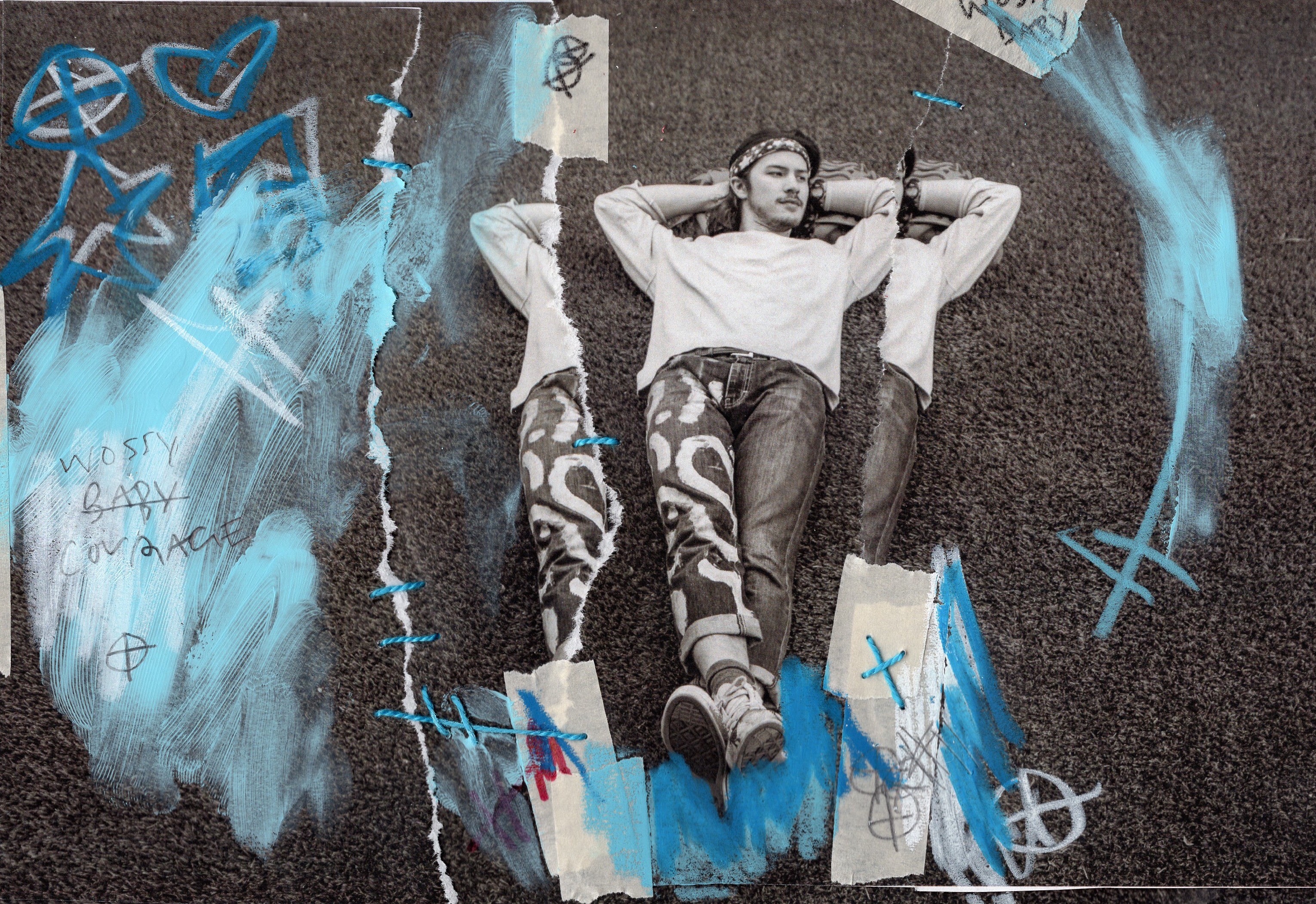
“I’m trying to make more engaging ways to make art. I’m trying to change someone’s context of what an object is … Now we have to make something that elicits a specific response, something that engages a little more directly. Something that makes someone say, ‘I would hang that in my room. I would destroy a TV to cover it in that thing. I’d wear it to a concert. I’d wear it to a fashion show.’
As a student of graphic design, Osella has discovered just how pervasive art can be in culture, and how design and art might intersect.
“Art is everywhere,” he says. “If you look at branding — branding is art. You’re conveying what a thing is. It’s a painting. A logo. Logos can change a person’s perspective.
“What I’m focused on now is turning StudioWOS into a brand. It’s all I wear and I want to engage others. I want to turn art into something that is more personalized. It’s a brand now. That’s how I view my art. I’m wearing WOS right now. You can’t wear a painting, but you can paint on your clothes. What better canvas than the things around you all the time?”
I point out that “wearing WOS” has a nice ring to it. He laughs.
“There’s no limit to what you can paint on. But once it feels like work, it’s not fun anymore. I’m motivated by a work ethic, but I won’t beat myself up for not finishing something. A lot of it is in the moment.”
The personal aspect of Osella’s work is accentuated by its permanence and momentum. He hardly stops to consider what he’s making; he simply creates, and lets the moment and his emotions guide him. These magazines, these clothes, are forever altered in his image. I examine the magazines further and try to draw my own conclusions about some of the visuals.
“It’s funny,” he says, sitting back in his chair. “Showing your work to another person, they can come back with an interpretation you could have never planned for.”
For more on UT student Nicholas Osella and StudioWOS , follow him on Instagram and Twitter @studiowos.





